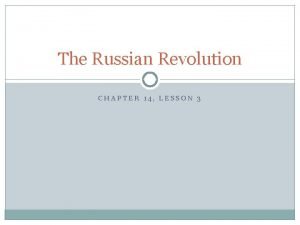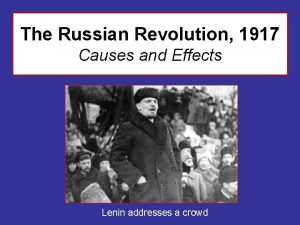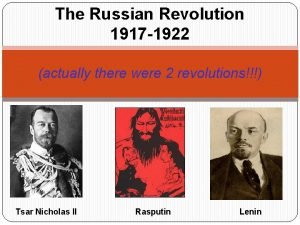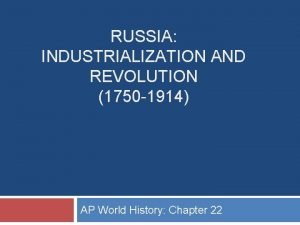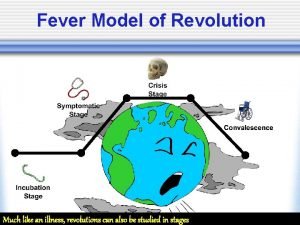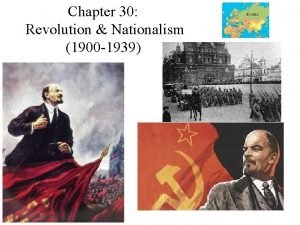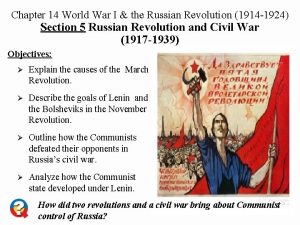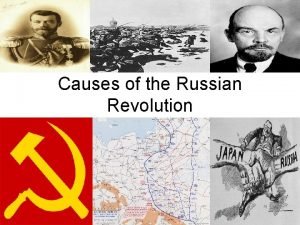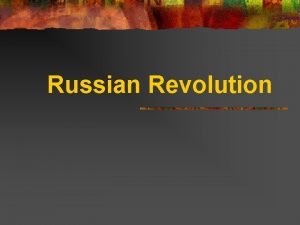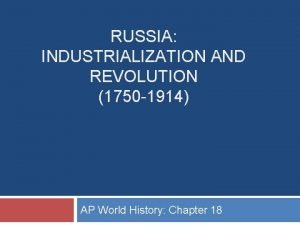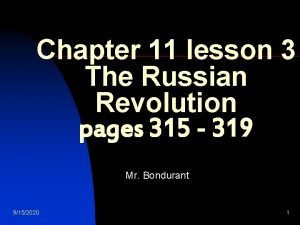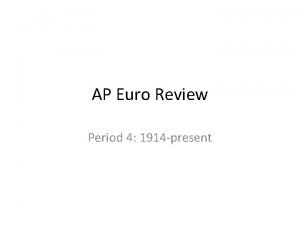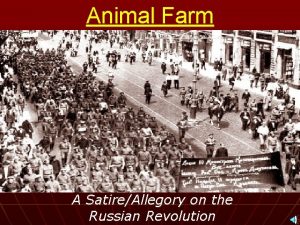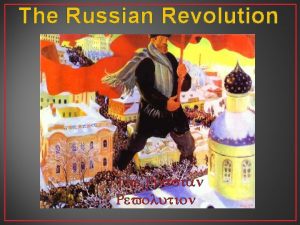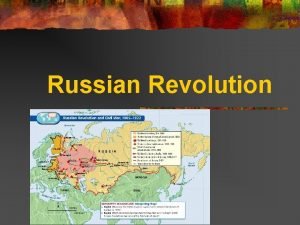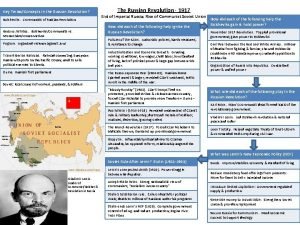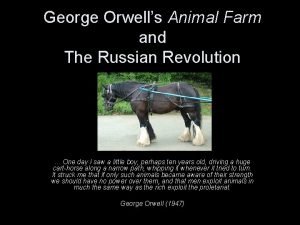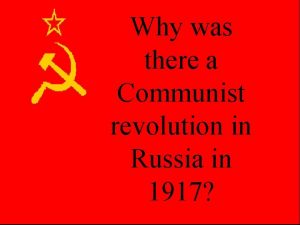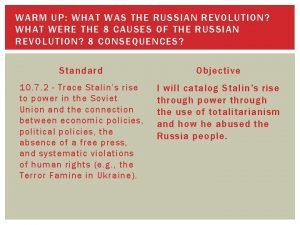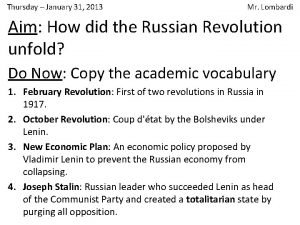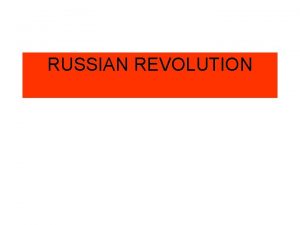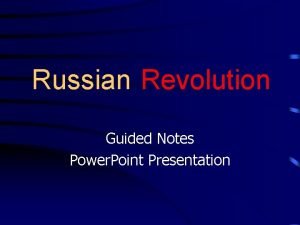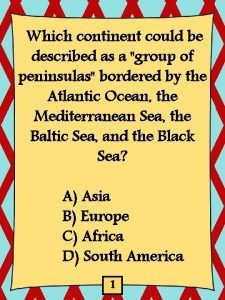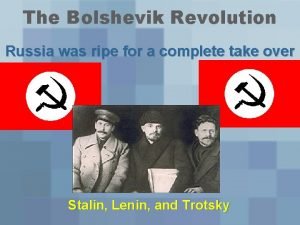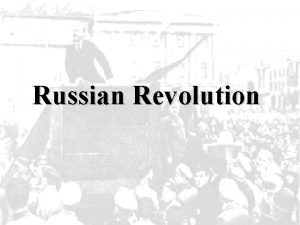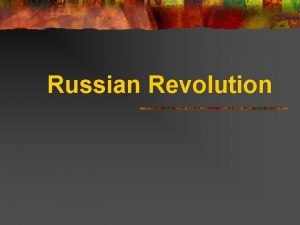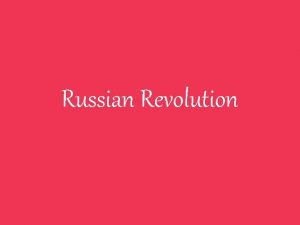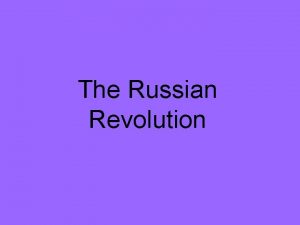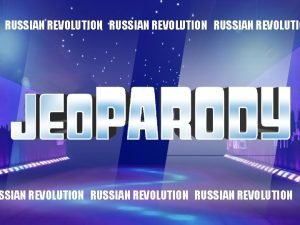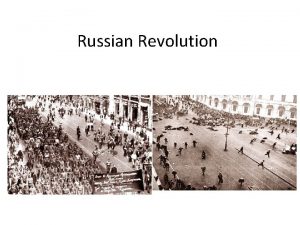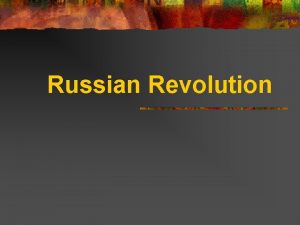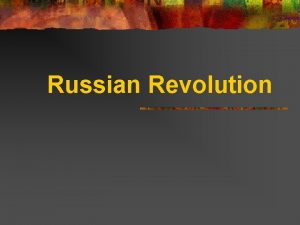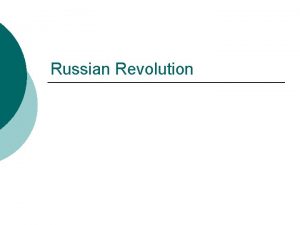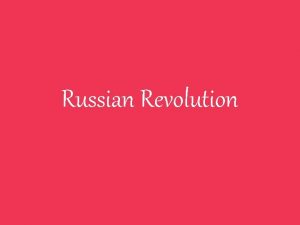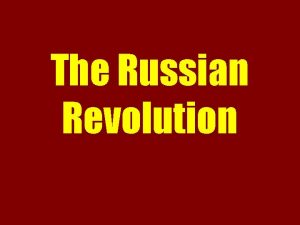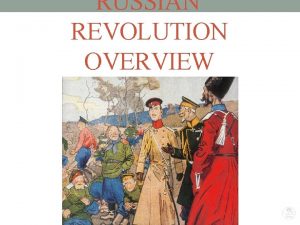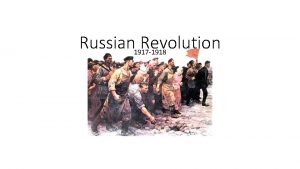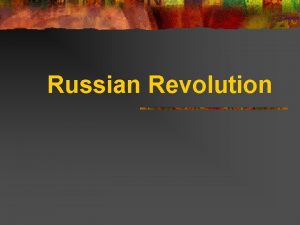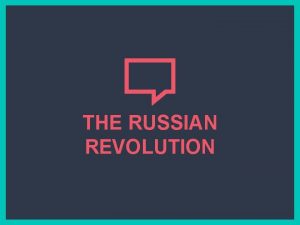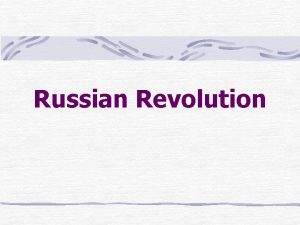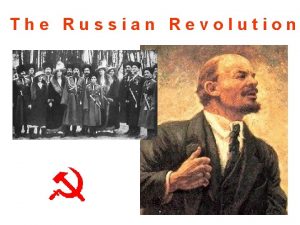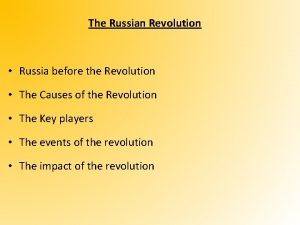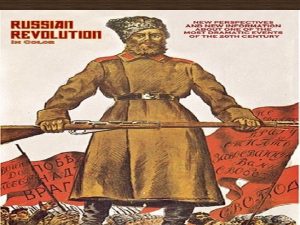16 4 The Russian Revolution Review Russia Russia








































- Slides: 40

16. 4 - The Russian Revolution

Review- Russia • Russia is the largest country in the world with a variety of geographic features and struggles • Harsh winters • Widely dispersed population • Napoleon, Caesar, and many others fail to conquer Russia

Review- Russia What we already know: • Russia was ruled by Czar Nicholas II- an absolute ruler • Russification enforced Russian language and Orthodox Christianity • Pogroms had forced millions of Jews to flee • Russia was not industrialized (lost the Russo-Japanese war as a result) • Majority of the peasant population lived in stark poverty • Bloody Sunday (1905)- massacre of peaceful protestors

WWI Intensifies Discontent • Outbreak of WWI fueled national pride and united Russians, but it was short-lived • Russian involvement in WWI made many preexisting problems worse: • Soldiers were poorly trained and dying- 2 M in 1915 alone • Incompetent military leadership • Lack of industrialization- factories weren’t producing enough supplies, transportation broke down

March Revolution (1917) Note- in • By 1917, peasants and workers are fed up with disastrous Russia, battle losses and food/fuel shortages at home known as • Workers strike, march through the streets shouting February “Bread!” Revolution • Troops refuse to fire on protestors- join them instead • Czar Nicholas II abdicates (gives up) the throne, and the Duma creates a provisional (temporary) government

Soviets • Outside of the provisional government, soviets are created in most cities • Soviets were more powerful and had more support than the provisional government • At first, soviets worked democratically within the government • Over time, the communist-leaning Bolsheviks took charge Sovietscouncils of workers and soldiers set up by revolutionaries

Review- Communism • During the Industrial Revolution, Karl Marx developed the idea of communism • A communist society has no class structure because everyone is equal and all property is shared. • Marx believed the masses would rise up to overthrow the Bourgeoisie • History has been the struggle of the Proletariat against Bourgeoisie • Government controls the means of production (factories, resources)

Vladimir Lenin • Vladimir Lenin was a socialist who adapted Marxist ideas to fit Russian conditions • Because Russia did not have a large urban proletariat, he called for an elite group to lead the revolution into communism • Called his group the Bolsheviks, which means “majority” (even though they only represented a small number of socialists) • Lenin had been exiled but was smuggled back in to Russia by the Germans during WWI to spread revolution and force Russia out of the war Bolsheviks = Communists

Peace, Land, Bread • Lenin’s goals were summed up in the slogan that gained him support: “Peace, Land, Bread” PEACELANDBREAD- Get Russia out of WWI End serfdom, give peasants land Increase food supply

November Revolution (1917) • In November 1917, Red Guards (armed factory workers) attacked and overtook the provisional government • Bolsheviks quickly seized power in other cities- made Moscow their capital and the Kremlin their headquarters • Lenin and the Bolsheviks ended private land ownership and redistributed land to peasants, gave workers control of factories Also known as the Bolshevik Revolution New flag symbolizing union between workers (hammer) and peasants (sickle)

Treaty of Brest-Litovsk • After the Bolshevik Revolution, Lenin wanted to get Russia out of WWI ASAP • Signed the Treaty of Brest-Litovsk, which negotiated peace between Russia and Germany • However, Germany punished Russia by forcing them to surrender huge amounts of territory

Civil War • Once Lenin gained control, civil war began in Russia • The Red Army- Bolsheviks/Communists • The White Army- Tsar loyalists, Allied powers • Brutality was common- White Army attempts to assassinate Lenin and slaughtered communist prisoners; The Red Army kills former Tsar Nicholas II and his entire family • Millions die from starvation as the civil war drags on for 3 years

War Communism • Communist forces also used terror to control their own people • Organized the Cheka- secret police force that executed citizens accused of taking action against the revolution • Adopted a policy known as “war communism” • Took over banks, mines, factories, railroads • Peasant farmers deliver crops to feed soldiers/hungry people in cities • Peasant laborers drafted into army or forced to work in factories • Red Army becomes highly effective (every 10 th man is shot if they fail)

Civil War In 1921, the Communist Red Army defeats the White Army

Union of Soviet Socialist Republics • In 1922, Lenin’s communist gov’t united much of the old Russian empire into the USSR/Soviet Union, a multinational state made up of European and Asian peoples • Theoretically, all member republics shared certain equal rights. In actuality, the Communist Party held all the power and used the army and secret police to enforce its will.

New Economic Policy • Lenin’s “war communism” had plummeted the economy- factory and mine output had fallen, peasants stopped producing grain knowing the gov’t would seize it • Adapted New Economic Policy (NEP) in 1921 - the state kept control of banks, trade, and large industries, but small businesses can open for profit and peasants can sell surplus crops for profit • Although it successfully revived the Russian economy, Lenin always saw the NEP as a temporary retreat from communism. The Soviet Union would soon return to “pure” communism. Is the NEP strict communism? Why or why not?

Stalin Comes to Power • Vladimir Lenin dies suddenly in 1924, and his death leads to a power struggle in the Communist Party • Primary contenders are Joseph Stalin and Leon Trotsky • Stalin was a shrewd political operator who had many people who owed him allegiance • Trotsky had helped Lenin establish the Bolshevik revolution, and was a well educated and talented leader Lenin Trotsky

Stalin Comes to Power • In the end, Stalin out-maneuvers Trotsky and strips him of his party membership. Trotsky flees to Mexico where he is later assassinated • Lenin had serious doubts about Stalin, writing shortly before his death: “Comrade Stalin, having become Secretary-General, has unlimited authority concentrated in his hands, and I am not sure whether he will always be capable of using that authority with sufficient caution. ”

Stalin’s 5 -year Plans • Stalin wanted the Soviet Union to become a modern industrialized power • Proposed the first of several “five-year plans” in 1928 to: • Build industry • Improve transportation • Increase farm production • To achieve these goals, Stalin set up a command economy Summarize in your own words! Command Economygovernment officials make all basic economic decisions and owns means of production

Command-vs-Capitalist Command Economy • Gov’t owns means of production • Gov’t makes decisions on production and distribution of resources Capitalist Economy Who owns the means of production? How are economic decisions made?

Industrial Success? • Stalin’s 5 year plans set huge production goals for all industries • The government pushed workers and managers to meet these goals by rewarding those who did and punishing those who did not • Industries in the Soviet Union did increase output, but at what cost? • Wages and standard of living remained low • Workers couldn’t strike • Managers focused primarily on production quotashigh quantity of low-quality goods • Produced heavy industry rather than consumer goods (clothes, cars, etc)

Collectivization • Stalin brought the agricultural industry under government control as well • Gov’t wanted farmers to produce more grain to feed city workers • Peasants worked on large state-owned farms called collectives • Government provided tractors, fertilizers, seeds • Peasants’ farm animals, tools, and machines were seized by the government • State set all prices and controlled access to supplies Summarize this in your own words!

Resistance to Collectivization • Peasants tried to resist collectivization by killing farm animals, destroying tools, and burning crops, but the government responded brutally • Peasants then tried growing just enough to feed themselves • Gov’t responded by seizing all of their grain for cities, purposely leaving them to starve- 5 -8 million died in the Ukraine alone • While collectivization did increase Stalin’s control over the peasantry, it did not successfully improve farm output

Control Through Terror • Under Stalin, the Soviet Union becomes a totalitarian state • To ensure obedience, Stalin used secret police, torture, and violent purges of his enemies • Anyone who dissented or spoke out against Stalin was sent to the Gulag, a series of brutal labor camps • Prisoners were given little food, inadequate shelter and clothing, and were forced to do extreme physical labor

The Great Purge • Stalin was super paranoid that rival leaders were plotting against him • Launched the Great Purge in 1934 • Targeted “Old Bolsheviks”, army heroes, industrial managers, academics, and ordinary citizens • 1936 -1938: series of “show trials” where former Communist leaders confessed to various crimes after The first five marshals (generals) of the Soviet Union. being tortured or their families threatened • Most targets of the Great Purge were simply sent straight to the Gulag

Impact of the Great Purge • Purges increased/solidified Stalin’s power- destroyed the old generation of revolutionaries and replaced them with younger party members who owed Stalin loyalty, plus highlighted the danger of dissent • But also destroyed many of the best and brightest- experts in industry, economics, engineering, talented writers and thinkers, most military leaders and half the military officers • The loss of so many military leaders would hurt the Soviet Union in 1941…

“Stalin ruthlessly used terror as a weapon against his own people. He perpetuated crimes against humanity, carried out politically motivated mass murders, and systematically violated his people’s individual rights. Police spies did not hesitate to open private letters or plant listening devices. A vast network of internal spies reported on groups or individuals. Nothing appeared in print without official approval. There was no free press, and no safe method of voicing protest. ”

Controlling Culture • Stalin forced artists and writers to follow a style called “socialist realism” to show the Soviet Union in a positive light • Those who ignored these guidelines found their access to materials and jobs limited, or worse, faced persecution by the government • Also had a policy of Russification across the Soviet Empire • Atheism became the state policy. Communists targeted the Russian Orthodox Church, Roman Catholics, and Jews • Tried to create their own ideology based on the writings of Marx and Lenin Poet Osip Mandelstam, arrested in 1938 and died in the Gulag

Propaganda • Stalin attempted to improve morale and faith in the communist system through propaganda What is propaganda? Under the leadership of the great Stalin forward to Communism! Gentleness of Stalin shines on the Future of our children Stalin in the Kremlin cares about each one of us!

Positives and Negatives of Socialism • • • Benefits Drawbacks Free education Low-cost housing Basic survival needs met Free daycare Free healthcare Women gain equality under the law • Limited housing meant that it was crowded and poor quality • Bread was available, but little supply of meat, fruit, other foods • Communist party members were the elite- only a small number of citizens could join the party

Comparing Revolutions American 1776 -Least Radical -Set the example -Democracy Russian 1917 -Seized peasant land -Government takes absolute control -Millions executed, sent to Gulag War French 1789 -1000 s executed -Middle class gained representation Terror Famine more power to the peasants and middle classes

Review The Bolshevik Revolution of 1917 in Russia was caused in part by 1. a forced famine in Ukraine 2. the failure of Czar Nicholas II to come to Serbia's aid 3. a shortage of military supplies and food during WWI 4. the establishment of Lenin's New Economic Policy (NEP)

Review A key principle of the economic theory of Communism is 1. restoration of a bartering system 2. organization of workers’ unions 3. government ownership of property 4. privatization of business

Review The Bolshevik Revolution of 1917 was a major turning point in history because 1. Russia became the first nation with a Communist economic system 2. it was the last revolution in the 20 th century 3. Russia ceased to be an important force in world affairs 4. the royal family was exiled to Mexico

Review Which statement best describes the political situation in the Soviet Union immediately after Lenin's death in 1924? 1. The nation adopted a constitutional monarchy. 2. Trotsky and his followers assumed full control of the Communist Party. 3. Popular elections were held to choose a new General Secretary. 4. A power struggle developed among Communist Party leaders.

Review The Bolshevik Party in 1917 gained the support of the peasant class because they promised them 1. "Peace, Land, and Bread" 2. "Liberty, Equality, Fraternity" 3. abolition of the secret police 4. democratic reforms in all levels of government

Review A major goal of Joseph Stalin’s five-year plans was to 1. encourage communist revolutions in the colonies of the European powers 2. transform the Soviet Union into an industrial power 3. expand the Soviet Union’s borders to include warm-water ports 4. reduce the amount of foreign aid coming from the Western Hemisphere

Review Totalitarian countries are characterized by 1. free and open discussions of ideas 2. a multiparty system with several candidates for each office 3. government control of newspapers, radio and television 4. government protection of people’s civil liberties

Review Which condition was a result of Joseph Stalin’s command economy? 1. Peasants were encouraged to sell surplus grain for personal profit. 2. The production of consumer goods increased. 3. National revenue increased allowing for greater individual spending. 4. The government controlled agriculture through collective farms.

Review The main purpose of the many purges and public trials that took place in the Soviet Union in the 1930 s was to 1. force the Jewish people to leave the Soviet Union 2. eliminate opposition to Joseph Stalin and his government 3. establish a free and independent court system in the Soviet Union 4. reform the outdated and inadequate agricultural system
 Russian revolution vs french revolution
Russian revolution vs french revolution There lived a russian man
There lived a russian man Chapter 27 world war 1 and the russian revolution
Chapter 27 world war 1 and the russian revolution Lesson 3 the russian revolution answer key
Lesson 3 the russian revolution answer key Causes and effects of the russian revolution
Causes and effects of the russian revolution Czar in russian revolution
Czar in russian revolution Russia after ww1
Russia after ww1 Russian industrialization ap world
Russian industrialization ap world Political cartoons
Political cartoons Fever model revolution
Fever model revolution Chapter 30 revolution and nationalism worksheet answers
Chapter 30 revolution and nationalism worksheet answers Kzbho6asboc -site:youtube.com
Kzbho6asboc -site:youtube.com Effect of russian revolution
Effect of russian revolution Http://www.history.com/topics/russian-revolution
Http://www.history.com/topics/russian-revolution Russian revolution of 1905 definition ap world history
Russian revolution of 1905 definition ap world history The russian revolution
The russian revolution Russian revolution 1917
Russian revolution 1917 Summary of animal farm
Summary of animal farm The russian revolution
The russian revolution The russian revolution
The russian revolution Russian revolution
Russian revolution The russian revolution
The russian revolution Introduction of russian revolution
Introduction of russian revolution Russian revolution effects
Russian revolution effects Causes of the russian revolution
Causes of the russian revolution Russian revolution
Russian revolution Russian revolution guided notes
Russian revolution guided notes Which number on the map represents the english channel?
Which number on the map represents the english channel? Why was russia ripe for revolution ww1
Why was russia ripe for revolution ww1 Economic causes of french revolution
Economic causes of french revolution The third agricultural revolution
The third agricultural revolution Hát kết hợp bộ gõ cơ thể
Hát kết hợp bộ gõ cơ thể Slidetodoc
Slidetodoc Bổ thể
Bổ thể Tỉ lệ cơ thể trẻ em
Tỉ lệ cơ thể trẻ em Chó sói
Chó sói Chụp tư thế worms-breton
Chụp tư thế worms-breton Chúa yêu trần thế
Chúa yêu trần thế Các môn thể thao bắt đầu bằng từ đua
Các môn thể thao bắt đầu bằng từ đua Thế nào là hệ số cao nhất
Thế nào là hệ số cao nhất Các châu lục và đại dương trên thế giới
Các châu lục và đại dương trên thế giới



